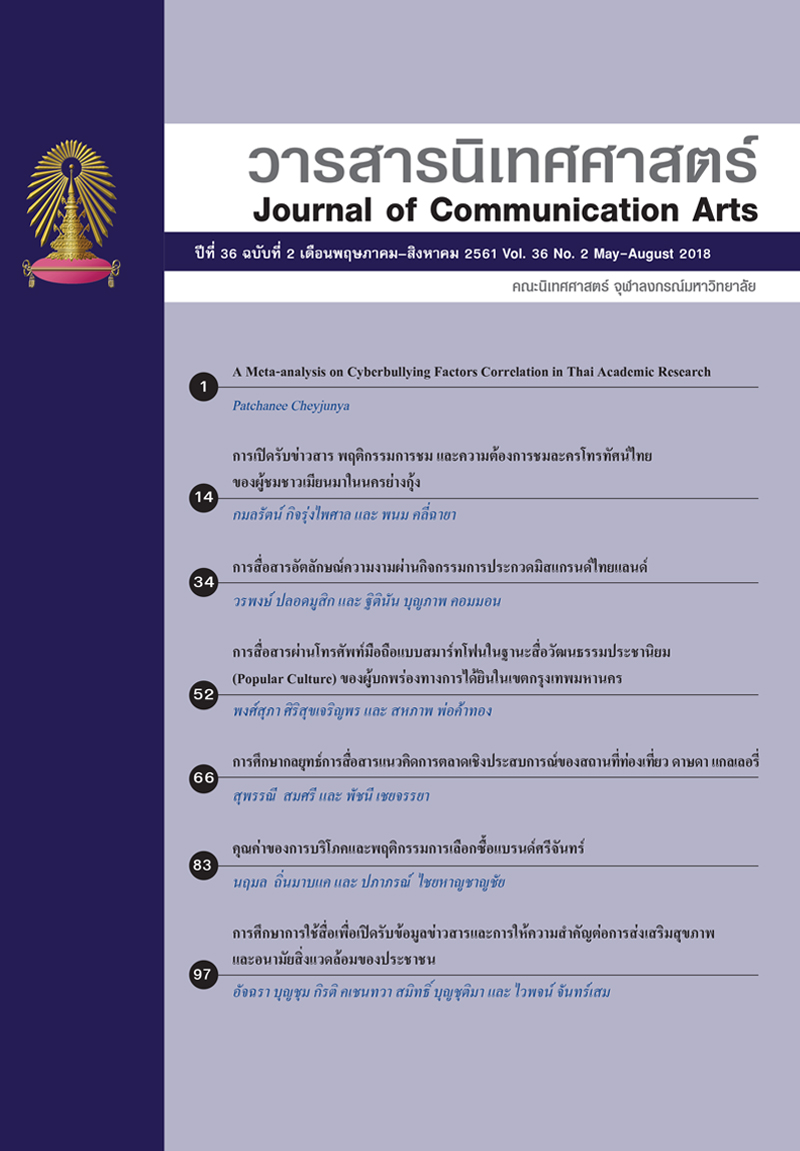การสื่อสารผ่านโทรศัพท์มือถือแบบสมาร์ทโฟนในฐานะสื่อวัฒนธรรมประชานิยม (Popular Culture) ของผู้บกพร่องทางการได้ยินในเขตกรุงเทพมหานคร
Main Article Content
Abstract
The research, Smartphone Communication Behavior as a Popular Culture of Hearing Impairment in Bangkok" aims to: 1) study the behavior of mobile communication via mobile phones. 2) to study the use of smartphone applications in the smartphone in Bangkok. 3) To study the factors that affect the use of mobile phones in smartphones of hearing impaired people in Bangkok as a popular culture. This research was employed the mixed method research, The data collection by quantitative research for analyzing and testing theories through questionnaires. The statistical methods, Frequency, percentage, mean, chi-square, standard deviation, T-test, One-Way Analysis of ANOVA and Pearson Product Moment Correlation were utilized for collecting and analyzing data with Qualitative Research by the techniques adept interview and participatory observation. The samples was hearing impaired people who use smartphone in Bangkok and those who communicate with hearing impaired, 100 participants which consisted of parents and their friends. (Because, the target group is a special group with a smaller population than the normal population. The researcher collected only 100 people.)
The quantitative research found that the majority of the samples were males rather than females. 77% more than males 23%. The hearing impaired persons aged 31-35years had more normal communication behaviors than those with hearing impairment. The behavior of using a smartphone was at a high level, with 3 to 6 times a day, with a duration of 10 - 30 minutes. In addition, there was an application of social networking on the phones. Most of the smartphones are 93% smart and use smartphone communication by using 100% social networking apps for updating news, friends and acquaintances from the behavior of mobile communication through smartphone and satisfied of using the application on the smartphone.
Hearing impaired people have behavioral communication via smartphone, taking advantage of technology to make communication faster and more comfortable, found that technology has changed the communication behavior of hearing impaired fully in the present time. It may be because of the technology of mobile communication on the smartphone. It has been developed to respond to various factors that contribute to the change of hearing impairment, such as psychological factors, attitudes, values, cultures, and language abilities.
On technology development, the smartphone can respond to the needs of the hearing impaired properly and they appreciates the importance of communicating via a smartphone and the accordance of social environment of the hearing impaired, Both the people and the hearing impaired were widely used
Smartphones. This was a main variable that caused them use smartphones and make the smartphone communication fall into the popular culture.
Article Details
References
พภัช เชิดชูศิลป์. (2557). พฤติกรรมการใช้ไลน์ที่มีผลต่อความพึงพอใจและการใช้ประโยชน์ของนักศึกษามหาวิทยาลัยศรีปทุม.บทความวิชาการ หลักสูตรนิเทศศาสมหาบัณฑิต คณะนิเทศศาสตร์, มหาวิทยาลัยศรีปทุม.
ภัทร ด่านอุดม. (2541).หากดูไม่เป็นการรบกวนก็จะชวนมาศึกษา Popular Culture กัน(พิมพ์ครั้งที่ 3).กรุงเทพฯ : สำนักพิมพ์รัฐศาสตร์สาร.
สำนักงานสถิติแห่งชาติ ศูนย์สารสนเทศยุทธศาสตร์ภาครัฐ.(2554), ผลสำรวจมูลค่าการตลาดโทรศัพท์มือถือแบบสมาร์ทโฟนในปี 2554 (ออนไลน์).เข้าถึงได้จาก:http://www.nic.go.th/ : [2555, 13 กันยายน].
สำนักงานสถิติแห่งชาติ.(2556), การสำรวจผู้ใช้โทรศัพท์มือถือ (ออนไลน์). เข้าถึงได้จาก: http://www.nso.go.th/ [2557, 22 กันยายน]
สำนักงานสถิติแห่งชาติ. (2555), จำนวนผู้บกพร่องทางการได้ยินในประเทศไทย (ออนไลน์). เข้าถึงได้จาก http://www.nso.go.th :[2555, 13 กันยายน].
สถาบันวิจัยประชากรศาสตร์และสังคม มหาวิทยาลัยมหิดล.(2557) , สารประชากรมหาวิทยาลัยมหิดลประชากรของประเทศไทย พ.ศ. 2557 (ออนไลน์).เข้าถึงได้จาก: http://www.ipsr.mahidol.ac.th [2557, 19 กรกฎาคม].
สำนักงานส่งเสริมและพัฒนาคุณภาพชีวิตคนพิการแห่งชาติ.(2557), รายงานข้อมูลสถานการณ์ด้านคนพิการ ในประเทศไทย ประจำปี 2557 (ออนไลน์).เข้าถึงได้จาก: http://dep.go.th [2557, 1 กันยายน].
หนังสือพิมพ์ไทยรัฐออนไลน์.(2557), เทคโนโลยีการสื่อสารทางโทรศัพท์มือถือแบบ 3G (ออนไลน์). เข้าถึงได้จาก : https://www.thairath.co.th/newspaper [2557, 22 กันยายน].
McQuail, D. (2005). McQuail's Mass Communication Theory.(5th edition). London: Sage Publications.
Rogers, E.M. & F. Floyd Shoemaker. (1971).Communication of diffusions: a cross cultural approach. (2nd edition)., Newyork: The Free Press,.
Yamane, Taro. (1973).Statistics: An Introductory Analysis (3rd edition). Newyork : Harper and Row Publication.


